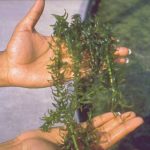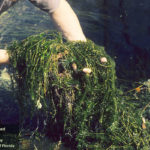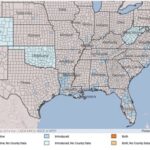Egeria densa
Non-Native
Illustration courtesy of University of Florida/IFAS Center for Aquatic and Invasive Plants. Used with permission.
What is Egeria?
Physical Characteristics
Leaves:
Lower Leaves:
Middle & Upper Leaves:
- Whorls of 4 to 6
- Immobile
- Crowded
- Straight
- Up to 1.5 inches long and 0.2 inches wide
Flowers:
- White
- 3 petals
- 3-lobed
Stem:
- Cylindrical
- Slender
- 0.08-0.13 inches thick
- Straight
- Branching
Roots:
- Rooted on the bottom or floating if broken off
Egeria is often confused with the native Elodea or the non-native Hydrilla. Hydrilla has one or more teeth on the underside of the midrib, neither Elodea nor Egeria have these midrib teeth. The teeth make Hydrilla feel rough when drawn through your hand from base to tip. Flowers of Egeria are larger than Hydrilla. Egeria leaves are larger than elodea and in whorls of 4 to 6 and not 3 as with elodea.
Where Does it Grow?
USDA, NRCS. The PLANTS Database (http://plants.usda.gov). National Plant Data Team, Greensboro, NC 27401-4901 USA.
Non-Native
Egeria is native to South America but has become naturalized in much of the Southeastern U.S. Egeria can be found in lakes, ponds, ditches, pools, and quiet streams.
Pros and Cons of Egeria
This plant is not native to North America, but has naturalized in much of the United States. While it is not illegal to possess this plant in Texas, it should not be introduced into new water bodies and should be treated with herbicide when present.








